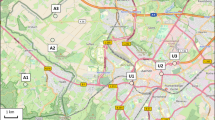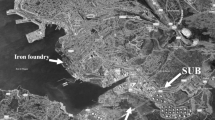Abstract
Mining activities represent a major source of environment contamination. The aim of this study was to evaluate the use of bees and ants as bioindicators to detect the heavy metal impact in post-mining areas. A biomonitoring programme involving a combination of honeybee hive matrices analysis and ant biodiversity survey was conducted over a 3-year period. The experimental design involved three monitoring stations where repeated sampling activities focused on chemical detection of cadmium (Cd), chrome (Cr) and lead (Pb) from different matrices, both from hosted beehives (foraging bees, honey and pollen) and from the surrounding environment (stream water and soil). At the same time, ant biodiversity (number and abundance of species) was determined through a monitoring programme based on the use of pitfall traps placed in different habitats inside each mining site. The heavy metal content detected in stream water from the control station was always below the analytical limit of quantification. In the case of soil, the content of Cd and Pb from the control was lower than that of mining sites. The mean heavy metal concentrations in beehive matrices from mining sites were mainly higher than the control, and as a result of regression and discriminant analysis, forager bee sampling was an efficient environmental pollution bioindicator. Ant collection and identification highlighted a wide species variety with differences among habitats mostly associated with vegetation features. A lower variability was observed in the polluted landfill characterised by lack of vegetation. Combined biomonitoring with forager bees and ants represents a reliable tool for heavy metal environmental impact studies.
Similar content being viewed by others
References
Andersen AN (1993) Ants as indicators of restoration success at a uranium mine in tropical Australia. Restor Ecol 1:156–167
Angiolini C, Bacchetta G, Brullo S, Casti M, Giusso Del Galdo G (2005) The vegetation of mining dumps in SW-Sardinia. Feddes Repertorium 116:243–276
Aru A (1993) The problem of heavy metals pollution in mining areas of Sardinia. Preliminary findings. Annali della Facoltà di Agraria dell’Università di Sassari 35:293–300
Bacchetta G, Casti M, Zavattero L (2007) Integration of vegetational and multitemporal analysis: a case study in the abandoned mine district of Montevecchio (South-western Sardinia). Annali di Botanica (Roma), NS 7:163–174
Bogdanov S (2006) Contaminants of bee products. Apidologie 37:1–18
Bogdanov S, Haldimann M, Luginbühl W, Gallmann P (2007) Minerals in honey: environmental, geographical and botanical aspects. J Apicult Res and Bee World 46:269–275
Bratu I, Georgescu C (2005) Chemical contamination of bee honey—identifying sensor of the environment pollution. J Cent Eur Agr 6:467–470
Cammell ME, Way MJ, Paiva MR (1996) Diversity and structure of ant communities associated with oak, pine, eucalyptus and arable habitats in Portugal. Ins Soc 43:37–46
Castracani C, Grasso DA, Fanfani A, Mori A (2010) The ant fauna of Castelporziano Presidential Reserve (Rome, Italy) as a model for the analysis of ant community structure in relation to environmental variation in Mediterranean ecosystems. J Insect Conserv 14:585–594
Cerdá X, Retana J, Cros S (1997) Thermal disruption of transitive hierarchies in Mediterranean ant communities. J Anim Ecol 66:363–374
Cerdá X, Retana J, Manzaneda A (1998a) The role of competition by dominants and temperature in the foraging of subordinate species in Mediterranean ant communities. Oecologia (Berl) 112:404–412
Cerdá X, Retana J, Cros S (1998b) Critical thermal limits in Mediterranean ant species: trade-off between mortality risk and foraging performance. Funct Ecol 12:45–55
Clarke KR, Gorley RN (2006) PRIMER v6: user manual/tutorial. PRIMER-E, Plymouth
Conti ME, Botrè F (2001) Honeybees and their products as potential bioindicators of heavy metals contamination. Environ Monitor Assess 69:267–282
Devillers J, Doré JC, Viel C, Marenco M, Poirier-Duchene F, Galand N, Subirana M (2002) Typology of French acacia honeys based on their concentrations in metallic and nonmetallic elements. In: Devillers J, Pham-Delégue MH (eds) Honey bees: the environmental impact of chemicals. Taylor & Francis, London, pp 248–268
Di Giacomo F, Franco MA, Giaccio M, Prota R, Floris I, Chessa M, Sferlazzo G (1996) Valutazioni statistische multivariate sul contenuto di metalli in mieli prodotti in prossimitá di fonti di inquinamento. Riv Merceol 35:295–310
Di Gregorio F, Massoli-Novelli R (1988) Impatto ambientale delle attività minerarie in Sardegna. Bollettino della Società Sarda di Scienze Naturali 26:17–42
Floris I, Satta A, Ruiu L (2007) Honeys of Sardinia (Italy). J Apicult Res and Bee World 46:198–209
Folgarait PJ (1998) Ant biodiversity and its relationship to ecosystem functioning: a review. Biodivers Conserv 7:1221–1244
Franco MA, Chessa M, Sferlazzo G, Giaccio M, Di Giacomo F, Prota R (1997) Bee pollen as an indicator of environmental pollution by heavy metals. Riv Merceol 36:67–78
Free JB, Williams IH, Pinsent RJFH, Townshend A, Biasi MS, Graham CL (1983) Using foraging honeybees to sample an area for trace metals. Environ Int 9:9–12
Freedman B, Hutchinson TC (1981) Source of metal and elemental contamination of terrestrial environments. In: Lepp NW (ed) Effect of heavy metal pollution on plants. Applied Science Publishers, London, pp 35–94
Hölldobler B, Wilson EO (1990) The ants. Springer, Berlin
Italian Legislative Decree (2001) Italian legislative decree 2 February 2001, n. 31 Attuazione della direttiva 98/83/CE relativa alla qualità delle acque destinate al consumo umano. Gazzetta Ufficiale della Repubblica Italiana 52, 3rd March 2001—Supplemento Ordinario 41.
Italian Ministerial Decree (1999) Italian ministerial decree 25 October 1999, n. 471. Regolamento recante criteri, procedure e modalità per la messa in sicurezza, la bonifica e il ripristino dei siti inquinati, ai sensi dell’articolo 17 del decreto legislativo 5 febbraio 1997, n. 22, e successive modificazioni e integrazioni. Gazzetta Ufficiale della Repubblica Italiana 293, 15th December 1999—Supplemento Ordinario 218.
Jones KC (1987) Honey as an indicator of heavy metal contamination. Water Air Soil Pollut 33:179–189
Leita L, Muhlbachova G, Cesco G, Barbattini R, Mondini C (1996) Investigation of the use of honey bees products to assess heavy metal contamination. Environ Monitor Assess 43:1–9
Louveaux J, Maurizio A, Vorwohl G (1978) Methods of melissopalinology. Bee World 59:139–157
Majer JD (1985) Recolonization by ants of rehabilitated mineral sand mines on North Stradbroke Is. Queensland, with particular reference to seed removal. Aust J Ecol 10:31–48
Mcgeoch MA (2007) Insects and bioindication: theory and progress. In: Stewart AJA, New TR, Lewis OT (eds) Insect conservation biology. Royal Entomological Society, CABI, UK, pp 144–174
Ottonetti L, Tucci L, Santini G (2004) Ant communities as indicators of environmental health: successional analysis in a rehabilitation context. REDIA 58:199–202
Peck SL, Mcquaid B, Campbell CL (1998) Using ant species (Hymenoptera: Formicidae) as a biological indicator of agroecosystem condition. Environ Entomol 27:1102–1110
Porrini C, Ghini S, Girotti S, Sabatini AG, Gattavecchia E, Celli G (2002) Use of honey bees as bioindicators of environmental pollution in Italy. In: Devillers J, Pham-Delégue MH (eds) Honey bees: the environmental impact of chemicals. Taylor & Francis, London, pp 186–247
Retana J, Cerdà X (2000) Patterns of diversity and composition of Mediterranean ground ant communities tracking spatial and temporal variability in the thermal environment. Oecologia (Berl) 123:436–444
Ricciardelli D’Albore G (1998) Mediterranean melissopalynology. Print Center University of Perugia, Italy
Room PM (1975) Diversity and organization of the ground foraging ant faunas of forest, grassland and tree crops in Papua New Guinea. Aus J Zool 23:71–89
Statgraphics plus (2001) Statgraphics Plus user’s guide, standard edn, vers 4. ManugisticsInc, Rockville, MD
Von der Ohe W, Persano Oddo L, Piana LM, Morlot M, Martin P (2004) Harmonized methods of melissopalynology. Apidologie 35(2004):S18–S25
Wayne L (1983) Bee miners join British Columbia God Hunt. Am Bee J (July) 3:635–637
Acknowledgments
This work was supported by grants from the local government of Sardinia (Italy), “Assessorato all’Ambiente, Medio Campidano Province” and “Parco Geominerario, Storico, Ambientale della Sardegna”, Research Project “Biomonitoring of the mining and coastal area of Medio Campidano”. This work was also supported by the operating programme of Regione Sardegna (European Social Fund 2007–2013), L.R. 7/2007, “Promotion of scientific research and technological innovation in Sardinia”.
Author information
Authors and Affiliations
Corresponding author
Additional information
Responsible editor: Stuart Simpson
Rights and permissions
About this article
Cite this article
Satta, A., Verdinelli, M., Ruiu, L. et al. Combination of beehive matrices analysis and ant biodiversity to study heavy metal pollution impact in a post-mining area (Sardinia, Italy). Environ Sci Pollut Res 19, 3977–3988 (2012). https://doi.org/10.1007/s11356-012-0921-1
Received:
Accepted:
Published:
Issue Date:
DOI: https://doi.org/10.1007/s11356-012-0921-1




